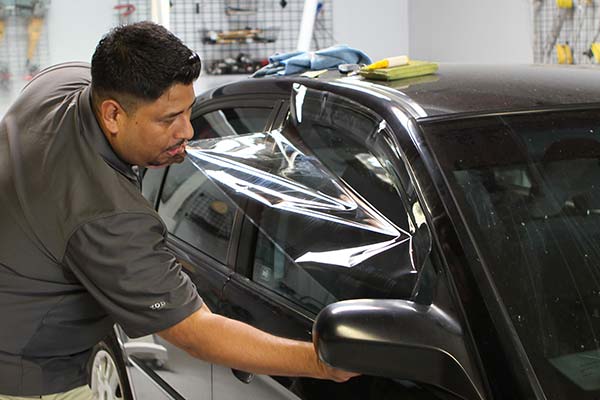Automotive Window Tinting
Automotive window tinting is the process of applying a thin film or layer of material to the windows of a vehicle to
It can be done for various reasons:
such as to enhance the window tinting appearance of the vehicle, to reduce glare, to provide privacy and security, and to protect the occupants and interior of the car from the harmful effects of UV rays.
Window tinting films come in various types:
including dyed, metallic, and ceramic. Dyed films are the most basic type, and they work by absorbing some of the visible
light passing through the glass. Metallic films contain small metal particles that reflect heat and block UV rays,
but they can interfere with radio and GPS signals:
Ceramic films are the most advanced type, and they use nano-ceramic technology to block heat and UV rays without affecting signal transmission.
The laws regarding automotive window tinting vary from country to country and state to state. In some places, there are restrictions on the level of tint that can be applied to the front and rear windows,
failure to comply with these laws can result in fines or other penalties:
It is important to research the laws in your area and choose a reputable and experienced installer to ensure that your window tinting is done safely and legally.
How does Window Tinting Work?
Window tinting is a process where a thin film is applied to a window to reduce the amount of light and heat that enters through the glass.
The tinting film is made of a thin layer of polyester or other materials that are coated with an adhesive and a layer of metal, dye or ceramic particles that absorb or reflect light.
When the tinting film is applied to a window:
it reduces the amount of visible light that passes through the glass. The amount of light that is blocked depends on the darkness of the tinting film.
The darkness of the tint is measured by the percentage of visible light that is allowed to pass through the glass, which is referred to as the VLT (visible light transmission) rating.
The tinting film also blocks a portion of the ultraviolet (UV):
rays that pass through the glass. This helps to protect the interior of a car or building from fading and damage caused by UV rays.
In addition to blocking light and UV rays:
window tinting can also reduce the amount of heat that passes through the glass. This is achieved by the tinting film's
ability to reflect and absorb heat:
As a result, the interior of a car or building can stay cooler, which can lead to energy savings by reducing the need for air conditioning.
Overall, window tinting is a cost-effective way to improve the comfort, energy efficiency, and privacy of a car or building.
UV Protection, Impact Resistant:
UV protection and impact resistance are two important properties that are often considered when selecting eyewear, particularly for outdoor activities.
UV protection refers to the ability of a lens to block harmful ultraviolet (UV):
radiation from the sun. Prolonged exposure to UV radiation can cause a variety of eye problems, including cataracts,
macular degeneration, and corneal sunburn. Therefore, it is important to choose eyewear with lenses that provide adequate UV protection.
Impact resistance, on the other hand, refers to the ability of a lens to withstand:
impact or damage from external forces. This is particularly important for activities such as sports, construction work,
or any other situation where the eyewear may be at risk of being hit by flying debris or other objects.
Many eyewear options are available that combine both UV protection and impact resistance:
such as polycarbonate lenses, which are a popular choice for safety glasses, sports goggles, and children's eyewear.
These lenses are lightweight, durable, and offer high levels of UV protection, making them an ideal choice for a wide range of activities.
It is important to note that while UV protection and impact resistance are important:
factors to consider when best window tinting selecting eyewear, there are many other factors to consider as well, such as the fit, style, and lens type.
It is best to consult with an eye care professional to determine the best eyewear option for your specific needs.

Comments
Post a Comment